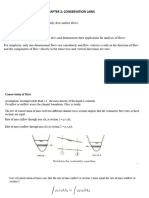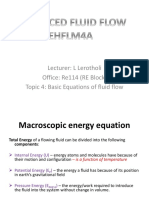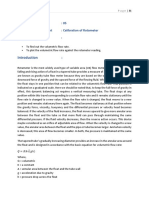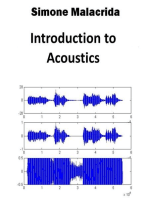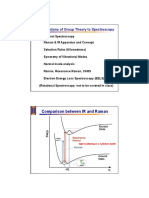Diffusion - Rev2019 PDF
Diffusion - Rev2019 PDF
Uploaded by
Hey YoCopyright:
Available Formats
Diffusion - Rev2019 PDF
Diffusion - Rev2019 PDF
Uploaded by
Hey YoOriginal Title
Copyright
Available Formats
Share this document
Did you find this document useful?
Is this content inappropriate?
Copyright:
Available Formats
Diffusion - Rev2019 PDF
Diffusion - Rev2019 PDF
Uploaded by
Hey YoCopyright:
Available Formats
MOLECULAR THEORY OF DIFFUSION:
Molecular diffusion or molecular transport can be defined as the transfer or movement of individual molecules through a fluid
by means of the random, individual movements of the molecules.
Schematic diagram of molecular diffusion process:
(2)
A
B B B
B B B B
B B
B B
B
A
(1)
Five interrelated quantities are used in diffusion theory:
• velocity, 𝑢
• flux relative to a plane of zero velocity, 𝑁 = 𝜌𝑀 𝑢𝑀 = 𝑁𝐴 + 𝑁𝐵
• flux across a plane, 𝐽𝐴 = 𝑢𝐴𝑑 𝐶𝐴
• concentration, 𝐶 and molar density, 𝜌𝑀
𝑑𝐶
• concentration gradient,
𝑑𝑧
Fick’s Law of Diffusion
Consider a binary mixture in two distinct phases with different concentrations of components A and B. The rate of mass transfer
by molecular diffusion perpendicular to and relative to a stationary surface which is at a fixed distance from the interface is
depicted by Fick’s Law at steady state:
𝑑𝐶𝐴
𝐽𝐴 = −𝐷𝐴𝐵
𝑑𝑧
𝐽 = 𝑑𝑖𝑓𝑓𝑢𝑠𝑖𝑜𝑛 𝑓𝑙𝑢𝑥 𝑜𝑟 𝑡ℎ𝑒 𝑟𝑎𝑡𝑒 𝑜𝑓 𝑚𝑎𝑠𝑠 𝑡𝑟𝑎𝑛𝑠𝑓𝑒𝑟 𝑏𝑦 𝑚𝑜𝑙𝑒𝑐𝑢𝑙𝑎𝑟 𝑚𝑜𝑡𝑖𝑜𝑛
𝐷 = 𝑚𝑎𝑠𝑠 𝑑𝑖𝑓𝑓𝑢𝑠𝑖𝑣𝑖𝑡𝑦, 𝑎𝑟𝑒𝑎/𝑡𝑖𝑚𝑒
𝐶 = 𝑐𝑜𝑛𝑐𝑒𝑛𝑡𝑟𝑎𝑡𝑖𝑜𝑛 𝑜𝑓 𝑎 𝑐𝑜𝑚𝑝𝑜𝑛𝑒𝑛𝑡, 𝑚𝑜𝑙/𝑣𝑜𝑙
𝑧 = 𝑑𝑖𝑠𝑡𝑎𝑛𝑐𝑒 𝑓𝑟𝑜𝑚 𝑖𝑛𝑡𝑒𝑟𝑓𝑎𝑐𝑒
General Case for Diffusion of Gases plus Conveyance
So far, we have considered Fick’s Law of diffusion in a stationary fluid (i.e., there has been no movement or bulk flow of the
entire phase of the binary mixture A and B.) The diffusion flux JA occurred solely because of the concentration gradient. The
rate at which moles of A passed a fixed point to the right, which will be taken as a positive flux is JA in kgmol/s.m2. This flux
can be converted to a velocity of diffusion of A to the right by
𝐽𝐴 = 𝑢𝐴𝑑 𝐶𝐴
𝑢𝐴𝑑 = 𝑑𝑖𝑓𝑓𝑢𝑠𝑖𝑜𝑛 𝑣𝑒𝑙𝑜𝑐𝑖𝑡𝑦 𝑜𝑓 𝐴, 𝑚/𝑠
Consider what happens when the whole fluid is moving in bulk (to the right).
Let uM be the molar average velocity of the whole fluid relative to a stationary point. To a stationary observer, A moves faster
than the bulk phase, since its diffusion velocity uAd is added to that of the bulk phase, uM.
𝑢𝐴 = 𝑢𝐴𝑑 + 𝑢𝑀
Stationary plane
uA
uAd uM
ChE 421: Heat and Mass Transfer Rev 2019
Engr. MMM Boado
Multiplying by CA, the total flux of component A is determined
C A uA = CA uAd + C A uM
NA = JA + C A uM
Total flux of A relative Diffusion flux relative Conveyance of A relative to
to a stationary point to the moving fluid the stationary point
Let N be the total flux of the whole stream relative to the stationary point: 𝑁 = 𝜌𝑀 𝑢𝑀 = 𝑁𝐴 + 𝑁𝐵
𝒅𝑪𝑨 𝑵𝑨 + 𝑵𝑩
𝐺𝑒𝑛𝑒𝑟𝑎𝑙 𝑓𝑙𝑢𝑥 𝑒𝑞𝑢𝑎𝑡𝑖𝑜𝑛: 𝑵𝑨 = −𝑫𝑨𝑩 + 𝑪𝑨
𝒅𝒛 𝝆𝑴
Evaluation of Mass Diffusivity:
In order to apply the diffusion equations, mass diffusivity, DV has to be established. Correlations and empirical equations are
found in Perry’s ChE HB 8th Ed
If the diffusivity is given at a certain temperature and pressure, say at standard conditions, it is possible to estimate the diffusivity
at a desired temperature and pressure by making use of the empirical equations as the basis. If the calculation is based on Chen
and Othmer correlation, the equation becomes,
𝑇 1.81 1
(𝐷𝑉 ) 𝑇,𝑃 = 𝐷𝑉 273𝐾,1𝑎𝑡𝑚 ∙
273.15 𝑃
MOLECULAR DIFFUSION OF GASES
Uni-component (one-way) diffusion
When only component A is being transferred, the total molar flux to or away from the interface; NB = 0. The general flux
equation can be integrated to yield:
𝐷𝐴𝐵 𝜌𝑀 𝜌𝑀 − 𝐶𝐴2
𝑁𝐴 = ln [ ]
∆𝑧 𝜌𝑀 − 𝐶𝐴1
𝑆𝑖𝑛𝑐𝑒 𝐶𝐴 + 𝐶𝐵 = 𝜌𝑀 , 𝑡ℎ𝑒𝑛 𝐶𝐴 = 𝑦𝐴 𝜌𝑀
𝐷𝐴𝐵 𝜌𝑀 1 − 𝑦𝐴2 𝐷𝐴𝐵 𝑃𝑇 𝑃𝑇 − 𝑃𝐴2
𝑁𝐴 = ln [ ] 𝑁𝐴 = ln [ ]
∆𝑧 1 − 𝑦𝐴1 ∆𝑧 𝑅𝑇 𝑃𝑇 − 𝑃𝐴1
Equimolar counter-diffusion
Component A and B have the same concentration and are diffusing into each other. The total flux of each component: NA = -NB
The conveyance term becomes zero.
𝑁𝐴 = 𝐽𝐴 = −𝑁𝐵 = −𝐽𝐵
𝑑𝐶𝐴 𝑑𝐶𝐵
−𝐷𝐴𝐵 + −𝐷𝐵𝐴 =0
𝑑𝑧 𝑑𝑧
For ideal gases, the molar density, 𝜌𝑀 is constant because diffusion happens at constant pressure and temperature.
𝑑𝐶𝐴 + 𝑑𝐶𝐵 = 0 𝑠𝑢𝑐ℎ 𝑡ℎ𝑎𝑡 𝐷𝐴𝐵 = 𝐷𝐵𝐴 = 𝐷𝑉
−𝐷𝑉 𝜌𝑀 −𝐷𝑉
𝐽𝐴 = (𝑦𝐴2 − 𝑦𝐴1 ) 𝐽𝐴 = (𝑃 − 𝑃𝐴1 )
∆𝑧 ∆𝑧 𝑅𝑇 𝐴2
ChE 421: Heat and Mass Transfer Rev 2019
Engr. MMM Boado
MOLECULAR DIFFUSION IN LIQUIDS
Diffusion of solutes in liquids is very important in many industrial processes, especially in such operations as liquid-liquid
extraction, gas absorption and distillation. Diffusion in liquids also occurs in many natural processes, such as oxygenation of
rivers and lakes by the air and diffusion of salts in blood.
Uni-component (one-way) diffusion
𝐷𝐴𝐵 𝐶𝑎𝑣𝑒 1 − 𝑥𝐴2
𝑁𝐴 = ln [ ]
∆𝑧 1 − 𝑥𝐴1
𝜌 𝜌
𝜌 ( ) +( )
𝑀 1 𝑀 2
𝐶𝑎𝑣𝑒 =( ) =
𝑀 𝑎𝑣𝑒 2
Equimolar Counter-diffusion
−𝐷𝑉 −𝐷𝑉 𝐶𝑎𝑣𝑒
𝐽𝐴 = (𝐶𝐴2 − 𝐶𝐴1 ) 𝐽𝐴 = (𝑥𝐴2 − 𝑥𝐴1 )
∆𝑧 ∆𝑧
Sample Problems:
1. A mixture of helium and nitrogen gas is contained in a pipe at 298 K and 1 atm total pressure which is constant
throughout. At one end of the pipe at point 1 the partial pressure PA,1 of He is 0.60 atm and at the other end 0.2 m, PA,2
= 0.20 atm. Calculate the flux of He at steady state assuming N2 remains stagnant ; DAB is 0.687 x 10-4 m2/s.
2. Ammonia gas (A) and nitrogen gas (B) are diffusing in counter-diffusion through a straight glass tube 2.0 ft long with
an inside diameter of 0.080 ft at 298 K and 101.32 kPa. Both ends of the tube are connected to large mixed chambers
at 101.32 kPa. The partial pressure of NH3 in one chamber is constant at 20.0 kPa and 6.666 kPa in the other chamber.
The diffusivity at 298 K and 101.32 kPa is 2.30 x 10-5 m2/s.
(a) Calculate the diffusion of NH3 in lbmol/hr and kg/s.
(b) Calculate the diffusion flux of N2
(c) Calculate the partial pressure at point 1.0 ft in the tube
3. Ammonia gas (A) is diffusing through a uniform tube 0.10 m long containing N 2 gas (B) at 1.0132 x 105 Pa and 298 K.
The diagram is similar to the figure below. At point 1, P A1 = 1.103 x 104 Pa and at point 2, PA2 = 0.507 x 104 Pa. The
diffusivity is 0.23 x 10–4 m2/s.
(a) Calculate the flux of ammonia at steady state
(b) Repeat for N2
4. An ethanol (A) – water (B) solution in the form of a stagnant film 2.0 mm thick at 293 K is in contact at one surface with
an organic solvent in which ethanol is soluble and water is insoluble. At point 1, the concentration of ethanol is 16.8
wt% and the solution density is 972.8 kg/m3. At point 2, the concentration of ethanol is 6.8 wt% and the density is
988.1 kg/m3. The diffusivity of ethanol is 0.740 x 10 -9 m2/s. Calculate the steady-state flux of ethanol.
5. Calculate the rate of diffusion of sugar through a stagnant film of coffee 0.10 cm thick when the concentrations at 15%
and 5%, respectively, on either side of the film. Assume the diffusivity of sugar through coffee under the given
conditions to be 0.70 x 10-5 cm2/s and the density of a 10% solution is 1.0139 g/cm3.
ChE 421: Heat and Mass Transfer Rev 2019
Engr. MMM Boado
SPECIAL CASES
Component A diffusing through stagnant, non-diffusing B
A. Diffusion with Change in Path Length
𝐷𝐴𝐵 𝑃𝑇 𝑃𝐴1 − 𝑃𝐴2
𝑁𝐴 = [ ]
∆𝑧 𝑅𝑇 (𝑃𝑇 − 𝑃𝐴 )𝐿
(𝑃𝑇 − 𝑃𝐴2 ) − (𝑃𝑇 − 𝑃𝐴1 )
(𝑃𝑇 − 𝑃𝐴 )𝐿 =
(𝑃 − 𝑃𝐴2 )
𝑙𝑛 𝑇
(𝑃𝑇 − 𝑃𝐴1 )
𝑡𝐹 = 𝑡𝑖𝑚𝑒 𝑓𝑜𝑟 𝑡ℎ𝑒 𝑙𝑒𝑣𝑒𝑙 𝑡𝑜 𝑑𝑟𝑜𝑝 𝑓𝑟𝑜𝑚 𝑎 𝑠𝑡𝑎𝑟𝑡𝑖𝑛𝑔 𝑝𝑜𝑖𝑛𝑡 𝑜𝑓 𝑧0 𝑡𝑜 𝑧𝐹
Pseudo-steady-state condition is assumed since the level drops slowly.
𝑛𝐴 𝑤𝐴 𝜌𝐴 𝑑𝑉 𝜌𝐴 𝑑𝑧
𝑁𝐴 = = = ( )= ( )
𝐴 𝑀𝐴 (𝐴) 𝑀𝐴 𝐴 𝑑𝑡 𝑀𝐴 𝑑𝑡
Combining equations and integrating yields
(𝑧𝐹 2 − 𝑧0 2 ) 𝜌𝐴 𝑅𝑇(𝑃𝑇 − 𝑃𝐴 )𝐿
𝑡𝐹 =
2 𝑀𝐴 𝐷𝑉 𝑃𝑇 (𝑃𝐴1 − 𝑃𝐴2 )
Example:
An Arnold cell is used to measure the diffusivity of acetone in air at 20C and 100 kPa pressure. At time = 0, the liquid acetone
surface is 1.10 cm from the top of the tube and after 8 hours of operation, the liquid surface drops to 2.05 cm. If the concentration
of acetone in air that flows over the top of the tube is zero, what is the diffusivity of acetone in air? At 20C, the vapor pressure
of acetone is 24 kPa and density is 790 kg/m3.
B. Diffusion through Varying Cross-section
Diffusion from a sphere to a surrounding medium
4𝜋𝐷𝑉 𝜌𝑀 1 − 𝑦𝐴2
𝑛𝐴 = ln [ ]
1 1 1 − 𝑦𝐴1
( − )
𝑟1 𝑟2
Since r2 → and y2 0 (usually negligible)
1
𝑛𝐴 = 4𝜋𝑟1 𝐷𝑉 𝜌𝑀 ln [ ]
1 − 𝑦𝐴1
Example: Evaporation of Naphthalene Sphere
1. A sphere of naphthalene having a radius of 2.0 mm is suspended in a large volume of still air at 318K and 1 atm. The surface
temperature of the naphthalene can be assumed to be 318 K and its vapor pressure at 318 K is 0.555 mmHg. The diffusivity
of naphthalene in air at 318 K is 6.92 x 10–6 m2/s. Calculate the rate of evaporation of naphthalene from the surface in kg/s.
2. A drop of liquid toluene is kept at uniform temperature of 25.9C and is suspended in air by a fine wire. The initial radius is
2.0 mm. The vapor pressure of toluene at 25.9C is 3.84 kPa and the density of liquid toluene is 866 kg/m3.
(a) Derive an equation to calculate the time for the drop to evaporate completely in a large volume of still air.
(b) Calculate the time, is seconds, for complete evaporation
ChE 421: Heat and Mass Transfer Rev 2019
Engr. MMM Boado
3. Ammonia gas (A) is diffusing at steady-state through N2 (B) by equimolar
counter-diffusion in a circular conduit 1.22 m long at 25C and a total pressure
of 101.32 kPa absolute. The partial pressure of ammonia at the left end is
25.33 kPa and 5.066 kPa at the other end. The conduit has a diameter of
0.0305 m at the left end and tapering uniformly to 0.0610 m at the right end.
The diffusivity is 0.023 x 10–4 m2/s. Calculate the rate of diffusion of ammonia.
TURBULENT DIFFUSION
𝑑𝐶𝐴
𝑳𝒂𝒎𝒊𝒏𝒂𝒓 𝒅𝒊𝒇𝒇𝒖𝒔𝒊𝒐𝒏 𝐽𝐴 = −𝐷𝑣
𝑑𝑧
𝑑𝐶𝐴
𝑻𝒖𝒓𝒃𝒖𝒆𝒏𝒕 𝒅𝒊𝒇𝒇𝒖𝒔𝒊𝒐𝒏 𝐽𝐴 = −(𝐷𝑣 + 𝜀𝑁 )
𝑑𝑧
𝜀𝑁 – eddy diffusivity
−(𝐷𝑣 + 𝜀𝑁 )𝜌𝑀
𝑬𝒒𝒖𝒊𝒎𝒐𝒍𝒂𝒍 𝒄𝒐𝒖𝒏𝒕𝒆𝒓 𝒅𝒊𝒇𝒇𝒖𝒔𝒊𝒐𝒏 𝐽𝐴 = (𝑦𝐴2 − 𝑦𝐴1 )
∆𝑧
(𝐷𝑣 + 𝜀𝑁 )𝜌𝑀
𝑘=
∆𝑧
𝑘 – mass transfer coefficient; usually based on equimolal flows
– rate of mass transfer per unit area, per unit concentration difference
Since 𝑁𝐴 = 𝐽𝐴 in equimolar diffusion, then: 𝑵𝑨 = 𝒌(𝒚𝑨𝟏 − 𝒚𝑨𝟐 )
(𝐷𝑣 + 𝜀𝑁 )𝜌𝑀 1 − 𝑦𝐴2
𝑼𝒏𝒊 − 𝒄𝒐𝒎𝒑𝒐𝒏𝒆𝒏𝒕 𝒅𝒊𝒇𝒇𝒖𝒔𝒊𝒐𝒏 𝑁𝐴 = ln [ ]
∆𝑧 1 − 𝑦𝐴1
𝑁𝐴 = 𝑘 ′ (𝑦𝐴1 − 𝑦𝐴2 )
𝑘′ – modified mass transfer coefficient that accounts for drift
1 − 𝑦𝐴2
𝑘 ′ (𝑦𝐴1 − 𝑦𝐴2 ) = 𝑘 ln [ ]
1 − 𝑦𝐴1
𝑦𝐴1 = 𝑦𝑖 – mole fraction diffusing component at the interphase
𝑦𝐴2 = 𝑦 – mole fraction diffusing component at any point away from the interphase
𝐿𝑒𝑡: (𝑦𝐴1 − 𝑦𝐴2 ) = (1 − 𝑦𝐴2 ) − (1 − 𝑦𝐴1 )
(1 − 𝑦𝐴2 ) − (1 − 𝑦𝐴1 )
𝑙𝑜𝑔𝑎𝑟𝑖𝑡ℎ𝑚𝑖𝑐 𝑚𝑒𝑎𝑛 𝑐𝑜𝑛𝑐𝑒𝑛𝑡𝑟𝑎𝑡𝑖𝑜𝑛 𝑑𝑖𝑓𝑓𝑒𝑟𝑒𝑛𝑐𝑒 (1 − 𝑦)𝐿 =
1 − 𝑦𝐴2
ln [ ]
1 − 𝑦𝐴1
𝑘
𝑘′ =
(1 − 𝑦)𝐿
𝒌(𝒚𝑨𝟏 − 𝒚𝑨𝟐 )
𝑵𝑨 =
(𝟏 − 𝒚)𝑳
ChE 421: Heat and Mass Transfer Rev 2019
Engr. MMM Boado
EVALUATION OF MASS TRANSFER COEFFICIENTS
Dimensionless Numbers:
The dimensionless numbers obtained by the usual dimensional analysis that are important in mass transfer operations are the
following:
𝑡𝑢𝑟𝑏𝑢𝑙𝑒𝑛𝑡 𝑑𝑖𝑓𝑓𝑢𝑠𝑖𝑜𝑛 𝑘𝐷
𝑆ℎ𝑒𝑟𝑤𝑜𝑜𝑑 𝑁𝑢𝑚𝑏𝑒𝑟, 𝑆ℎ = =
𝑚𝑜𝑙𝑒𝑐𝑢𝑙𝑎𝑟 𝑑𝑖𝑓𝑓𝑢𝑠𝑖𝑜𝑛 𝐷𝑉
𝑖𝑛𝑒𝑟𝑡𝑖𝑎𝑙 𝑓𝑜𝑟𝑐𝑒𝑠 𝐷𝐺 𝐷𝑢𝜌
𝑅𝑒𝑦𝑛𝑜𝑙𝑑 ′ 𝑠 𝑁𝑢𝑚𝑏𝑒𝑟, 𝑅𝑒 = = =
𝑣𝑖𝑠𝑐𝑜𝑢𝑠 𝑓𝑜𝑟𝑐𝑒𝑠 𝜇 𝜇
𝑚𝑜𝑚𝑒𝑛𝑡𝑢𝑚 𝜇 𝑣
𝑆𝑐ℎ𝑚𝑖𝑑𝑡 𝑁𝑢𝑚𝑏𝑒𝑟, 𝑆𝑐 = = =
𝑚𝑎𝑠𝑠 𝑑𝑖𝑓𝑓𝑢𝑠𝑖𝑣𝑖𝑡𝑦 𝜌𝐷𝑉 𝐷𝑉
Mass Transfer Correlations are found Chapter 5 of Perry’s HB
Situation Equation Flow regime
Vertical wetted wall column 𝑆ℎ = 0.023𝑅𝑒 0.81 𝑆𝑐 0.44 Re = 2000 – 35,000
Sc = 0.6 – 2.5
Flow over flat plate 𝑆ℎ = 0.332𝑅𝑒 1/2 𝑆𝑐1/3 Local
𝑆ℎ = 0.664𝑅𝑒 1/2 𝑆𝑐1/3 Average
Re < 3 x 105 ; Sc > 0.6
Flow over flat plate 𝑆ℎ = 0.0292𝑅𝑒 0.8 Local
𝑆ℎ = 0.0365𝑅𝑒 0.8 Average
Re > 1 x 105 ; Sc = 1
Gas flow past single sphere 𝑆ℎ = 2 + 0.552𝑅𝑒 0.53 𝑆𝑐1/3 Re = 1 – 48,000
Sc = 0.6 – 2.7
Flow thru tubes 𝑆ℎ = 0.023𝑅𝑒 0.83 𝑆𝑐1/3 Re = 2100 – 35,000; Sc = 0.6 – 3000
(liquid)
Sc near 1 (gases)
Flow thru tubes 𝑑
0.668 ( ) 𝑅𝑒 𝑆𝑐
𝑑
( )
𝑆ℎ = 3.66 + 𝑥 𝑥 < 0.1; 𝑅𝑒 < 2100
2/3 𝑅𝑒 𝑆𝑐
𝑑
1 + 0.4 [( ) 𝑅𝑒 𝑆𝑐]
𝑥
Liquid flow past single sphere 𝑆ℎ = 2 + 0.95𝑅𝑒 0.5 𝑆𝑐1/3 Re = 2 – 2000
Liquid flow past single sphere 𝑆ℎ = 0.347𝑅𝑒 0.62 𝑆𝑐1/3 Re = 2000 – 17,000
Flow thru particles in agitated 𝑆ℎ = 2 + 0.6𝑅𝑒 1/2 𝑆𝑐1/3 Use terminal velocity of particles to
vessel containing vertical 𝑑𝑝 2 |𝜌𝑝 − 𝜌|𝑔 be used in Reynolds number
baffles 𝑢𝑇 =
18𝜇
1. Calculate the value of the mass-transfer coefficient and the flux for mass transfer from a sphere of naphthalene to air at 45°C
and 1atm abs flowing at a velocity of 0.305 m/s. The diameter of the sphere is 0.0254m. The diffusivity of naphthalene in air at
45°C is 6.92x10-6 m2/s and the vapor pressure of solid naphthalene is 0.555 mmHg.
ρ = 1.113 kg/m3 ρA = 1044.52 kg/m3
μ = 1.93 x 10 Pa.s
-5
2. Air at 1 atm and 100C flows at a flowrate of 15 m/min normal to a long, circular, 1-in-diameter cylinder made of
naphthalene. (a) Calculate the average sublimation flux in kg/s.m2. (b) For the same conditions, calculate the initial average
rate of sublimation if the flow is inside the tube (Di = 1in). (c) Compare this result to that for a bed packed with naphthalene
spheres with a void fraction of 0.5. ρA = 962.5 kg/m3
ChE 421: Heat and Mass Transfer Rev 2019
Engr. MMM Boado
You might also like
- AP Biology Test Cheat Sheet (Photosynthesis)Document22 pagesAP Biology Test Cheat Sheet (Photosynthesis)Mr. IntelNo ratings yet
- Vapour Diffusion Coefficient of AcetoneDocument8 pagesVapour Diffusion Coefficient of Acetonemaf_oliveira100% (1)
- S Announcement 20872 PDFDocument90 pagesS Announcement 20872 PDFHey YoNo ratings yet
- S Announcement 16221Document6 pagesS Announcement 16221Carlo HafallaNo ratings yet
- Lecture 4Document22 pagesLecture 4Fakhir JuttNo ratings yet
- Unit 1 Concept and TheoryDocument57 pagesUnit 1 Concept and TheoryRahaf HammadNo ratings yet
- Diffusion Mass Transfer-Lecture One-1Document20 pagesDiffusion Mass Transfer-Lecture One-1EDWIN SIMBARASHE MASUNUNGURENo ratings yet
- 3 Steady State DiffusionDocument25 pages3 Steady State DiffusionShahadat AwanNo ratings yet
- Lecture Notes 2 - Mass Trasnfer 1-1Document14 pagesLecture Notes 2 - Mass Trasnfer 1-1Agyei MichaelNo ratings yet
- Che318 Part1 Gas-Diffusion Rev1aDocument28 pagesChe318 Part1 Gas-Diffusion Rev1apiusNo ratings yet
- Ccb2053 Chap 2 Lecture 1Document34 pagesCcb2053 Chap 2 Lecture 1Yassin Roslan50% (2)
- Unit 2. Absorption & StrippingDocument22 pagesUnit 2. Absorption & StrippingThabo ThaboNo ratings yet
- Chapter4-Convective Mass TransferDocument39 pagesChapter4-Convective Mass TransferRadwan AymanNo ratings yet
- Mass Transfer 1 CLB 20804Document54 pagesMass Transfer 1 CLB 20804KumaranNo ratings yet
- Conservation LawsDocument40 pagesConservation LawsProficient WritersNo ratings yet
- 1 Fundamentals - All Diffusivity TablesDocument29 pages1 Fundamentals - All Diffusivity Tablesaddanki raghavendraNo ratings yet
- Chapter-3 Fluid DynamicsDocument51 pagesChapter-3 Fluid DynamicsS.M Umer SiddiquiNo ratings yet
- 4.basic Equations of Fluid FlowDocument31 pages4.basic Equations of Fluid FlowMAHLATSE MULALANo ratings yet
- Mass Transfer Slides - CHE304 - Chapter 27Document50 pagesMass Transfer Slides - CHE304 - Chapter 27RehabNo ratings yet
- EECQ - 4242 - Distributed Flow RoutingDocument4 pagesEECQ - 4242 - Distributed Flow RoutingEICQ/00154/2020 SAMUEL MWANGI RUKWARONo ratings yet
- Mass Transfer Slides - CHE304 - Chapter 24Document53 pagesMass Transfer Slides - CHE304 - Chapter 24RehabNo ratings yet
- FM 5 Bernoulli and Energy EquationsDocument47 pagesFM 5 Bernoulli and Energy Equationsالياس يونس مرغلانيNo ratings yet
- CH 24Document58 pagesCH 24نزار الدهاميNo ratings yet
- Mass Transfer Slides - CHE304 - Chapter 26Document51 pagesMass Transfer Slides - CHE304 - Chapter 26RehabNo ratings yet
- Chapter 9: Agitation and Aeration Agitation: Che 514A: Biochemical EngineeringDocument9 pagesChapter 9: Agitation and Aeration Agitation: Che 514A: Biochemical EngineeringEzekielNo ratings yet
- Mass Transfer 1 CLB 20804Document54 pagesMass Transfer 1 CLB 20804muhammad fazmiNo ratings yet
- ME 601TEGD Unit V - Nozzles CondensersDocument54 pagesME 601TEGD Unit V - Nozzles CondensersAyush SinghalNo ratings yet
- Mass Transfer NotesDocument75 pagesMass Transfer NotesRahul NathNo ratings yet
- Transport Phenomena (Transfer Processes)Document38 pagesTransport Phenomena (Transfer Processes)esiri aluyaNo ratings yet
- Thermodynamic Cycles Chapter 5Document50 pagesThermodynamic Cycles Chapter 5Arnab BanerjeeNo ratings yet
- Pieces of The General Mass Balance EquationDocument5 pagesPieces of The General Mass Balance Equationprasad wakodeNo ratings yet
- Chapter Six (Mass Energy Analysis of Control Volume) PDFDocument51 pagesChapter Six (Mass Energy Analysis of Control Volume) PDFايات امجد امجدNo ratings yet
- MODULE 5 - OrificeDocument20 pagesMODULE 5 - OrificeGrace MagbooNo ratings yet
- Fluid Mechanics HandoutDocument146 pagesFluid Mechanics HandoutmarimlaclarkgeraldNo ratings yet
- Gas-Liquid Mass Transfer in Cellular SystemsDocument7 pagesGas-Liquid Mass Transfer in Cellular Systemsfaye100% (1)
- SPC407-Lec 3Document42 pagesSPC407-Lec 3Devender PuniaNo ratings yet
- Module Notes Open Channel Flow and Flow MeasurementDocument42 pagesModule Notes Open Channel Flow and Flow Measurementslawek780303No ratings yet
- UNIT 1 PPT Mass TransferDocument18 pagesUNIT 1 PPT Mass Transferrtmwpnhd26No ratings yet
- Dip. - Theory of BernoullisDocument19 pagesDip. - Theory of BernoullisDan KiswiliNo ratings yet
- Mass Transfer-1Document38 pagesMass Transfer-1shahzadali0786No ratings yet
- MCEE5210 2023F L6 Rate-Based MethodDocument74 pagesMCEE5210 2023F L6 Rate-Based Methodtc1992423No ratings yet
- Experiment No.: 05 Name of The Experiment: Calibration of Rotameter ObjectivesDocument8 pagesExperiment No.: 05 Name of The Experiment: Calibration of Rotameter ObjectivesMd Afif AbrarNo ratings yet
- Thermodynamics I-Chapter 5Document15 pagesThermodynamics I-Chapter 5mohamed.salem.2026No ratings yet
- Fluid DynamicsDocument13 pagesFluid DynamicsAnik MahmudNo ratings yet
- Mass Transfer Coefficient Class NoteDocument22 pagesMass Transfer Coefficient Class NoteNayan Halder100% (2)
- ME 4411 - 05-Fluid Flow Concept and Basic EquationDocument35 pagesME 4411 - 05-Fluid Flow Concept and Basic EquationgmostafeezNo ratings yet
- Lecture 3-MassDocument16 pagesLecture 3-Mass501238196002No ratings yet
- 화학공학입문설계 강의노트 7 수정Document10 pages화학공학입문설계 강의노트 7 수정wani anaNo ratings yet
- Mass Transfer Slides - CHE304 - Chapter 23Document53 pagesMass Transfer Slides - CHE304 - Chapter 23RehabNo ratings yet
- Chapter 4 - 1 Fluid DynamicsDocument60 pagesChapter 4 - 1 Fluid DynamicsChara ZerihunNo ratings yet
- MO102 Lec-6 V2Document39 pagesMO102 Lec-6 V2Sheba SYNo ratings yet
- 3 Interphase Mass TransferDocument15 pages3 Interphase Mass TransferBiswa JitNo ratings yet
- Lecture 05, 06Document13 pagesLecture 05, 06Faiq Ali FaiqNo ratings yet
- Differential EquationsDocument25 pagesDifferential EquationsNilo Daniel MielesNo ratings yet
- Introduction and Molecular Mass Transfer (24-1)Document21 pagesIntroduction and Molecular Mass Transfer (24-1)نزار الدهاميNo ratings yet
- Bernoulli's Theorem Demonstration PDFDocument6 pagesBernoulli's Theorem Demonstration PDFNabilaSofeaNo ratings yet
- Compressible Flow 1Document32 pagesCompressible Flow 1Fahim TanvirNo ratings yet
- Explain Quantum Physics With a Single-Particle in Motion: Anharmonic OscillatorFrom EverandExplain Quantum Physics With a Single-Particle in Motion: Anharmonic OscillatorNo ratings yet
- Atmospheric Distillation: Variable ValueDocument1 pageAtmospheric Distillation: Variable ValueHey YoNo ratings yet
- Che 527: Che Law, Contracts, Specifications and Ethics Engr. MMM BoadoDocument4 pagesChe 527: Che Law, Contracts, Specifications and Ethics Engr. MMM BoadoHey YoNo ratings yet
- Aspen HYSYS-Basic Course: Case Study IVDocument8 pagesAspen HYSYS-Basic Course: Case Study IVHey YoNo ratings yet
- Industrial Waste: Che 513: Industrial Waste Management & Control Engr. MMM Boado, Ms EneDocument9 pagesIndustrial Waste: Che 513: Industrial Waste Management & Control Engr. MMM Boado, Ms EneHey YoNo ratings yet
- Intensity and Nature of Physical Agents: t1 t2 E (T 2 T 1) R (T 1) (T 2)Document3 pagesIntensity and Nature of Physical Agents: t1 t2 E (T 2 T 1) R (T 1) (T 2)Hey YoNo ratings yet
- MOD3 Labor LawDocument6 pagesMOD3 Labor LawHey YoNo ratings yet
- % Available ChlorineDocument6 pages% Available ChlorineHey YoNo ratings yet
- Filtration PDFDocument8 pagesFiltration PDFHey YoNo ratings yet
- Physics 2 Laboratory: Instrumentation & Process ControlDocument13 pagesPhysics 2 Laboratory: Instrumentation & Process ControlHey YoNo ratings yet
- Effectiveness Graphs by Kays & LondonDocument2 pagesEffectiveness Graphs by Kays & LondonHey YoNo ratings yet
- Application of Irradiation For Food Preservation: Seminar ONDocument19 pagesApplication of Irradiation For Food Preservation: Seminar ONPrashant KumarNo ratings yet
- Y10 C9 Worksheet - Specific Heat CapacityDocument4 pagesY10 C9 Worksheet - Specific Heat CapacityshafiqaNo ratings yet
- Van Urk Indole TLC Test PDFDocument11 pagesVan Urk Indole TLC Test PDFabazaba151No ratings yet
- Structural ConnectionsDocument205 pagesStructural ConnectionsbsitlerNo ratings yet
- Marmolit SolidStraw (Safety)Document11 pagesMarmolit SolidStraw (Safety)Tariq AkhtarNo ratings yet
- Insulation Plaster TdsDocument3 pagesInsulation Plaster TdsaliNo ratings yet
- Mobil Glygoyle™ 11, 22, and 30 Mobil Glygoyle™ 11, 22, and 30 Mobil Glygoyle™ 11, 22, and 30 Mobil Glygoyle™ 11, 22, and 30Document4 pagesMobil Glygoyle™ 11, 22, and 30 Mobil Glygoyle™ 11, 22, and 30 Mobil Glygoyle™ 11, 22, and 30 Mobil Glygoyle™ 11, 22, and 30EduleofNo ratings yet
- History and Applications of Diamond-Like CarbonDocument7 pagesHistory and Applications of Diamond-Like CarbonRaul RodríguezNo ratings yet
- Sacke Lean Gas Burners PDFDocument2 pagesSacke Lean Gas Burners PDFhk168No ratings yet
- Assignment of MELCS For Video ProductionDocument5 pagesAssignment of MELCS For Video ProductionNic's VlogsNo ratings yet
- Radiation Heat Transfer: Course ContentsDocument21 pagesRadiation Heat Transfer: Course ContentsJainil GajjarNo ratings yet
- Biomolecules (DPP - 1) - CompressedDocument26 pagesBiomolecules (DPP - 1) - CompressedALI ASHRAFNo ratings yet
- d2914 So2 Content of AtmosphereDocument14 pagesd2914 So2 Content of AtmosphereArunkumar ChandaranNo ratings yet
- Fiitjee: Solutions To AIEEE-2007-CHEMISTRY Paper Code (O) - 1Document9 pagesFiitjee: Solutions To AIEEE-2007-CHEMISTRY Paper Code (O) - 1Lokesh KumarNo ratings yet
- Las Smaw 9 - Q2 W3-8Document29 pagesLas Smaw 9 - Q2 W3-8Daryl TesoroNo ratings yet
- ZEF Ciiioes1348Document6 pagesZEF Ciiioes1348Zulman EfendiNo ratings yet
- Experiment 1 - Basic Chem FARISHDocument8 pagesExperiment 1 - Basic Chem FARISHMUHAMMAD FAIDZ DARWISH BIN FAIDZAL MoeNo ratings yet
- GURPS - Fantasy GearDocument2 pagesGURPS - Fantasy GearHugo BritoNo ratings yet
- Bateria UPSDocument17 pagesBateria UPSDAVIS GUZMAN PEREA CABARCASNo ratings yet
- Tablet Press ModelDocument22 pagesTablet Press Modelmarcelo100% (2)
- Mckeen2014 PDFDocument28 pagesMckeen2014 PDFashok_abclNo ratings yet
- Applications of Group Theory To SpectrosDocument59 pagesApplications of Group Theory To SpectrosYasin ÖztürkNo ratings yet
- Chemical Engineering Department, University of Technology, Baghdad, IraqDocument19 pagesChemical Engineering Department, University of Technology, Baghdad, IraqaliNo ratings yet
- TLCDocument4 pagesTLCPrince SharmaNo ratings yet
- BRINE REPORT Naeem PDFDocument24 pagesBRINE REPORT Naeem PDFKaleem AhmedNo ratings yet
- Mls 410 Lec - Histopathologic and Cytologic Techniques: Infiltration, Embedding & SectioningDocument11 pagesMls 410 Lec - Histopathologic and Cytologic Techniques: Infiltration, Embedding & Sectioningchristian Jay HorseradaNo ratings yet
- Pharmacognosy-I: Dr. Wafaa M.A. Alshakh HamedDocument81 pagesPharmacognosy-I: Dr. Wafaa M.A. Alshakh HamedАбу ДжудNo ratings yet
- E. Steam Power Plant - Pe - ExamDocument4 pagesE. Steam Power Plant - Pe - ExamallovidNo ratings yet
- Metronidazole Tablets (Metronidazoli Compressi)Document1 pageMetronidazole Tablets (Metronidazoli Compressi)Pedro Marcelo Alva PlasenciaNo ratings yet














